The western Pyrenees — in and out of France and Spain from castles to caldrons
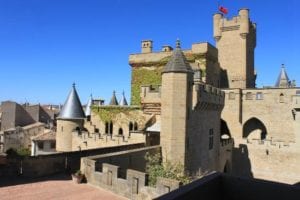
The Royal Palace at Olite
The Pyrenees are among my favorite mountain ranges. They are imposing and cut a clear swath between France and Spain. However, these mountains are still welcoming, gentle at times, and enfolding. The brilliant green landscape, the morning fog, the legends that still live, and the obscure history that can be found in Pyrenees valleys make this one of the most pleasant places in the world to visit.
New highways have made what were once arduous drives faster and more comfortable. But, I still like to take my time here in these mountains by driving along the twisting narrow roads. Some of these destinations are still only accessible by just such roads that wind through beautiful nature and surprising history.
This article is a peek into the world of the far western Pyrenees where France, Spain, and the Atlantic meet. Each segment of these mountains offers additional panoramas of nature and history. Some of these cities and towns are arguably in the foothills, but they all make up the region where the mountains meet the plains of Spain.
Olite
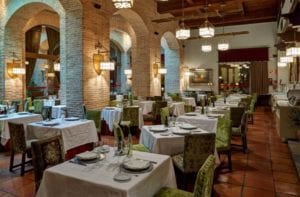
The dining room at Parador of Olite
This small town of Olite is home to one of the most beautiful Spanish castles. It sits majestically with conical towers at the foothills of the Pyrenees. The palace is surrounded by a small town whose narrow streets have not changed much from medieval days and the town is surrounded by vineyards claiming some of Spain’s top bodegas.
Few small towns offer such charm and wonderful accommodations. The Olite Parador is breathtaking, with rooms featuring exposed beams and stone walls. The dining room (below) is a step back in time with rustic tables set dramatically beneath soaring archways and a wooden ceiling.
In the hills behind the town, about a 20-minute drive, is the dead-end town of Ujue. Yes, the road ends here on this hilltop crowned with a large church and a couple of small restaurants. The church is interesting, but the restaurants are fabulous. Look into eating there for lunch if it fits into your itinerary. The specialties are the local game (sometimes still with buckshot to be found), lamb chops cooked over dried grape vines, and migas (breadcrumbs). This is a wonderful meal that should not be missed.
Olite to Roncesvalles
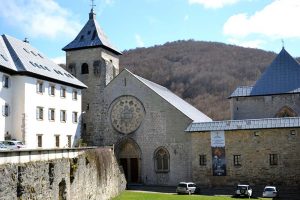
Roncesvalles Monestary
From Olite, a small, but improved, winding road takes travelers alongside the Rio Urrobi northward into the mountains. Eventually, the forests break to reveal the town of Burgette — once the haunt of Hemingway when he was trout fishing — and eventually the road reaches Roncesvalles, where the famous monastery stands at the border of France and Spain.
Roncesvalles is where the Song of Roland took place. It was the first epic poem that was written in the French vernacular. It told of Charlemagne’s retreat from Pamplona being chased by Basque warriors irate with his dismantling of the town’s defenses. (Muslims were the foes in the poem.) The poem focuses on Roland, the commander of the rear guard, his sounding of his horn, and his valiant death.
The historic monastery at the mountain pass was the place where the King of Spain’s party came to negotiate his marriage to the Duke of Burgandy’s niece. And today, it is one of the first stops in Spain for pilgrims beginning their journey along the Camino de Santiago after an arduous climb from France.
St. Jean Pied du Port
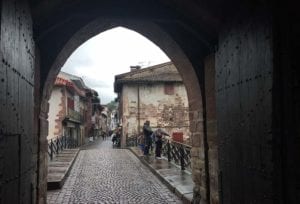
St. Jean Pied du Port
Following the road through the plunging mountainside that marks the French border, the twisting road passes the supposed location of the legendary battle that was described in the Song of Roland. After an almost hour-long drive, the road straightens and arrives at St. Jean Pied du Port, dominated by a giant citadel that crowns a hill overlooking the river.
The town itself is picture perfect and packed with shops selling Basque crafts and knick-knacks. A postcard view can be seen from the bridge crossing the Nive River. This can be a nice spot for a lunch or dinner; however, do not make the mistake of arriving at 2 p.m. from Spain and expecting to see restaurants open. Here, the French customs prevail. That means lunch from noon to 2 pm and dinners between 7 and 10 pm.
READ ALSO: 6 ways to find Spanish savings
From St. Jean Pied du Port, take the road that heads due west to Saint-Ethienne-de-Baigorry. There, the road rises precipitously up jagged mountains and along sheer sheets of stone. At the village of Arizcun, where the Bidasoa River begins its route to the sea, turn north. Eventually, after another half-hour of traversing narrow roads where cars and trucks are obliged to wait at times for each other to pass, the road passes through Urdax and comes to Zugarramurdi, famous for its massive witch trials in the era of the inquisition.

Zugarramurdi Witch Museum
Zugarramurdi
This small town that is known for its witches, is really a monument to common sense during the Inquisition. Back in 1609, the largest witchcraft case ever heard during the Inquisition was held here. Some claim that it is still the largest judicial action ever taken.
More than 7,000 people were carted to Logroño for a formal trial and only about 30 were finally convicted. However, the head of the Inquisition realized that the zealous investigations of witchcraft were out of hand and that the thousands of “confessions” could not be true. Several higher-ranking clerics noted that they had grown up in this region and they had no knowledge of witchcraft before the outset of the trial. The Bishop of Pamplona added his incredulity. In the end, the rules for evidence and conviction of witchcraft were instituted and from 1614 no more witches were burned in Spain, though the burnings at the stake went on for decades in other parts of Europe.
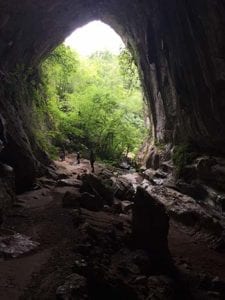
Caves of Zugarramurdi
When discussing the witchcraft trials with locals, many claim that the Catholic Church came down hard initially on supposed witchcraft in the Pyrenees as a way to disrupt the strong Basque matriarchal society. With many of the men in the villages either on mountainsides tending flocks of sheep or on whaling vessels sailing across the seas, women ran the towns and villages. Their strong presence irritated the hierarchy of the church
The Witch Museum is an excellent place to get to understand the frenzy that had taken over the Inquisitors. And, the Caves of Zugarramurdi provide an evocative place to try and conjure up visions of witches and revels with the devil that investigators claimed happened here.
Hotel Donnamaria’ko Benta is one of my favorite small hotels in the Pyrenees. The affordable hotel is run by two sisters, Lorea and Haizea, has only five rooms, and is recommended as a Bib Gourmand restaurant by Michelin. The peace and quiet of the valley, filled with wonderful walks and historic buildings, together with excellent meals, leave little more to be desired in any accommodation.
Finally, follow the narrow roads from Zugarramurdi as they wind down the Pyrenean mountainsides, zigging and zagging between France and Spain. These roads eventually take travelers to the wonderful area where France, Spain, and the Atlantic Ocean meet. Here, take time to explore Hondarribia, St. Jean de Luz, and San Sebastian. This area has some of the most beautiful beaches, towns, and gourmet dining that can be found anywhere in the world.

Charlie Leocha is the President of Travelers United. He has been working in Washington, DC, for the past 14 years with Congress, the Department of Transportation, and industry stakeholders on travel issues. He was the first consumer representative to the Advisory Committee for Aviation Consumer Protections appointed by the Secretary of Transportation from 2012 through 2018.



